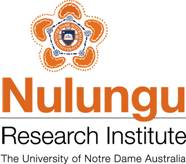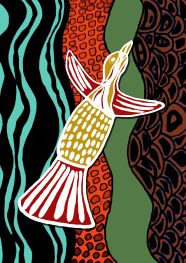Nulungu Insights provides an avenue for Aboriginal people and collaborators working in the Kimberley region of Western Australia with an opportunity to publicly inform, discuss and present their activities and research. Contributions may be authored by Aboriginal communities, as well as local and visiting researchers. It is a non-peer reviewed publication, but articles are subject to editorial oversight. Papers are aimed at audiences within the community, organisations or government networks.
Artwork: Seeing Country by Nyapuru Laurel
-

A lifelong journey in Aboriginal affairs and community: Nulungu reconciliation lecture 2021
Robert Isaacs
In this 2021 Nulungu Reconciliation lecture, Dr Robert Isaacs AM OAM will explore the meaning of reconciliation and the lessons of his personal journey in two worlds. As part of the Stolen Generation, and born at the dawn of the formal Aboriginal Rights Movement, this lecture outlines the changing social attitudes through the eyes of the lived experience and the evolving national policy framework that has sought to manage, then heal, the wounds that divided a nation. Aspirations of self-determination, assimilation and reconciliation are investigated to unpack the intent versus the outcome, and why the deep challenges not only still exist, but in some locations the divide is growing. The Kimberley is an Aboriginal rights location of global relevance with Noonkanbah at the beating heart. The Kimberley now has 93 percent of the land determined through Native Title yet the Kimberley is home to extreme disadvantage, abuse and hopelessness. Our government agencies are working “nine-to-five” but our youth, by their own declaration, are committing suicide out of official government hours. The theme of the Kimberley underpins this lecture. This is the journey of a man that was of two worlds but now walks with the story of five - the child of the Bibilmum Noongar language group and the boy that was stolen. The man that became a policy leader and the father of a Yawuru-Bibilmum-Noongar family and the proud great-grandson that finally saw the recognition of the courageous act of saving fifty shipwrecked survivors in 1876.
-

Dampier Peninsula’s community navigators empowering Kimberley families through their Aboriginal-led Woombooriny Amboon Angarriiya Partnership Initiative (WAAPI)
Jessica Bunning, Janella Isaac, Rosana Smith, Joshua Augustine, and Belinda Sampi
The Dampier Peninsula is home to a pristine coastal landscape and rugged country with diverse and abundant marine life, flora and fauna. Valuable Aboriginal cultural knowledge, traditions and science are still shared and practiced, while local tourism and industry opportunities are poised for growth.
Throughout this unique and beautiful region, an exciting project led by the Aboriginal people of Beagle Bay, Djarindjin, Lombadina and Ardyaloon communities called WAAPI - the Woombooriny Amboon Angarriiya Partnership Initiative is taking shape. It aims to empower Aboriginal families and improve outcomes for their children, young people and families living across the Dampier Peninsula region. WAAPI’s focus is on creating strong families, strong leaders and strong communities with an Indigenous governance family empowerment model. This provides a model for a ‘voice’ to facilitate local decision-making and ensure Aboriginal-led, designed and delivered positive social change.
-

Marnda gardairri: Facilitation of an Indigenous Ranger rock art workshop
Melissa Marshall, Lynley A. Wallis, and Kate Golson
The Marnda Gardairri Indigenous Rangers Workshop was held from 3–5 October 2017 on the Burrup Peninsula in the Pilbara region of Western Australia. The event, which was hosted by the Murujuga Aboriginal Corporation (MAC), brought together rangers from across Australia to discuss rock art conservation and management. The workshop was given the title ‘Marnda Gardairri’ as this means rock scratching/engraving on the Burrup Peninsula.
The workshop was developed by MAC in collaborative partnership with Rio Tinto Iron Ore-Pilbara Operations and the Nulungu Research Institute (The University of Notre Dame Australia). Rio Tinto and Woodside Petroleum funded the workshop, with Mel Marshall and Lynley Wallis of Nulungu engaged to coordinate and facilitate the event, assisted by Kate Golson.
-

Mapu kungulu, mapu ngarlu, mapu muwarr wakajku (Open mind, good feeling, good talk and business for all of us)
Anna Dwyer, Maria Morgan, and Gillian Kennedy
In September 2019 the Nulungu Research Institute hosted 20 judges from the District Court of Western Australia (WA) and five justices of the Supreme Court of WA at the University of Notre Dame Australia (UNDA) Broome Campus for a cultural immersion experience and judicial conference. The program included an overnight trip to Karajarri country and a visit to the Bidyadanga Aboriginal Community (formerly La Grange Mission). The aim was to provide the judicial officers with an insight into the contexts of Aboriginal people living in remote parts of the Kimberley, and to offer tailored professional development sessions to assist them in their work with Aboriginal people. This paper provides the background and an overview of the program, portions of the feedback we received from the participants, and plans for extension of this initiative into the future.
-

Sisters of St John of God in the Kimberley: A journey near completion and a story still to be told
Paul Lane
The Sisters of St John of God (SSJG) arrived in the Kimberley in 1907 and through the following 110 years played a critical role in the story of the region: when it comes to health, education, and social development in the Kimberley over the past century the SSJG are central characters. As with many other institutions, the SSJG have reached a time in their journey where they are seeking to transition their values and experiences into some lasting benefit for the Kimberley and its people. It may be that the Sisters will no longer have a physical presence in this part of Australia but they are determined that their story will, in whatever way possible, provide some understanding to future generations of a part of the country whose colonial history bears so little resemblance to that of any other part of Australia.
-

Rewriting the history of the Native Mounted Police in Queensland
Lynley A. Wallis, Noelene Cole, Heather Burke, Bryce Barker, Kelsey Lowe, Iain Davidson, and Elizabeth Hatte
The Archaeology of the Native Mounted Police in Queensland project, jointly led by Nulungu research fellow Dr Lynley Wallis, is a long-overdue exploration into the nature of frontier invasion. Several of our team members have worked in Queensland for many decades and, in every Aboriginal community in which we’ve worked, stories are told about the ‘killing times’ or the ‘war’, as community members call the period when the Native Mounted Police (NMP, also referred to as the ‘Native Police’) were operating. Many community members have asked us over the years to record their stories about the massacres that took place, or have shown us places associated with the police camps or the massacre sites, and often told us that they would like to know more about what happened. These requests eventually led to the archaeologists on this project coming together, talking with key Aboriginal people and communities, and developing a research project to address their interests — the project described in this paper is the result.





